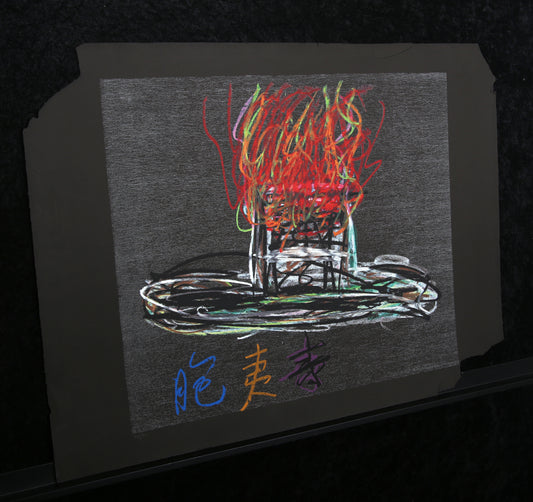Collection: Paik, Nam June
1932 July 20: Nam June Paik was born in Seoul, Korea, the son of a textile and steel manufacturer. He died in 2006 in Miami Beach, Florida. 1950 Outbreak of the Korean War: the family fled to Tokyo via Hong Kong. 1952-1956 Paik studied Western aesthetics, musicology, and art history at the University of Tokyo. His thesis was on the German composer Arnold Schoenberg. 1956-1958 He studied music history at the University of Munich and composition with Wolfgang Fortner (1907-1987) at the Freiburg University of Music. 1958-1963 Paik worked with Karlheinz Stockhausen (born 1928) in the WDR Studio for Electronic Music. A key experience for his artistic development was his encounter with the American composer John Cage (1912-1992) in Darmstadt in 1958. In 1959, based on the "Hommage € John Cage," Paik first developed the concept of his action music: Here, random tones and noises have the same significance as the classical sounds of an instrument or moments of silence. The smashing of instruments is intended to deliberately shock the audience and inspire further developments. In 1962, he participated in "Fluxus. International Festival of Newest Music" in Wiesbaden. From then on, Paik incorporated television into his art, pursuing the goal of making the foundations of electronic music visible through the visual medium of television. In 1963, he held his first solo exhibition at the Parnass Gallery in Wuppertal: "Exposition of Music - Electronic Television." Prepared pianos, sound objects, and twelve manipulated televisions were exhibited. These screens offered the viewer the opportunity to creatively influence the artwork. Television now becomes Paik's preferred medium, through which he demonstrates the mutability of artworks. This is typical of the international Fluxus movement of Wolf Vostell and George Macunias. In 1963/64, Paik travels to Japan. With the electrical engineer Shuya Abe, Paik experiments with the combination of color television and electromagnetism. These are his first attempts to paint with technical means instead of brushes and paint. Also with Abe, he builds a robot that imitates humans. This is the "great-grandfather" of his later "Family of Robots." From 1964 to 1967, Paik goes to New York and meets cellist Charlotte Moorman. They work closely together for several years. Paik designs numerous objects for her ("TV Bra," "TV Cello"). In 1967, Moorman appears semi-nude at a performance of his "Opera Sextronique." She and Paik are arrested by the New York police. 1965 Paik and Moorman participate in the "24 Hours" happening with Joseph Beuys, Wolf Vostell, and others at the Parnass Gallery in Wuppertal. He acquires one of the first models of a portable video camera. That same evening, he publishes his recordings: "Television has attacked us all our lives, now we're fighting back" because "now we're making our own television." Paik becomes the father of video art. 1966 The installation "TV-Cross" is exhibited at the Stockholm Museum of Technology, combining several televisions into a single sculpture for the first time. 1969/70 Paik and Abe develop the video synthesizer and further expand the possibilities of electronic painting. From 1970 onward, a series of works called "closed circuits" appeared: the most famous example is the Video Buddha. An ancient Buddha figure sits in front of a television and is simultaneously recorded by a camera. The image of the Buddha statue therefore appears simultaneously on the screen—the circuit is closed. Unlike a mirror, the television displays a right-side-up image. 1977 Married video artist Shigeko Kubota. Since 1979 Professor at the Düsseldorf Art Academy. 1982 First retrospective at the Whitney Museum of American Art, New York. For this exhibition, Paik designed the first architectural video installation: the V-yramid in the shape of a pyramid. At the Centre George Pompidou in Paris, he constructed an installation of 384 monitors and showed his Tricolor Video. These exhibitions increased Nam June Paik's worldwide reputation. 1984 To kick off the Orwell Year, Paik organized the satellite broadcast "Good Morning, Mr. Orwell" on January 1st. Artists and musicians participated in the show from Paris and New York: Joseph Beuys, Ben Vautier, Yves Montand, Laurie Anderson, Peter Gabriel, Charlotte Moorman, and others. 1986 Paik presented his "Family of Robots" in Cincinnati, USA, for which he used state-of-the-art video monitors and video disc players. 1987 At documenta 8 in Kassel, he honored his artist friend with the triptych "Beuys - Voice." Joseph Beuys had died the previous year. He was accepted as a member of the German Academy of Arts in West Berlin. 1988 On the occasion of the Olympic Games in Seoul, he realized another major project. "The More the Better" was a media tower consisting of 1,003 monitors. Television stations from 12 countries provided the film footage. Since 1988, Paik has lived in New York and Wiesbaden. 1993 Paik exhibited video works in the German Pavilion at the Venice Biennale, including "Sistine Chapel" and "Reclining Buddha." 1997 Paik participated in the major art exhibition "The Modern Age - Art in the 20th Century" in Berlin. 1998 In June, Paik was awarded the Kyoto Prize, endowed with 700,000 DM, which was presented to him in November in the presence of the imperial family. Previous awards include the Kurt Schwitters Prize, Hanover (1989), the Goslar Kaiserring (1991) and the UNESCO Picasso Medal (1992)
-
Paik, Nam June - Burning Hat (For Joseph Beuys) - Color serigraph - damaged
Regular price €450,00 EURRegular priceUnit price / per€1.500,00 EURSale price €450,00 EURSale



